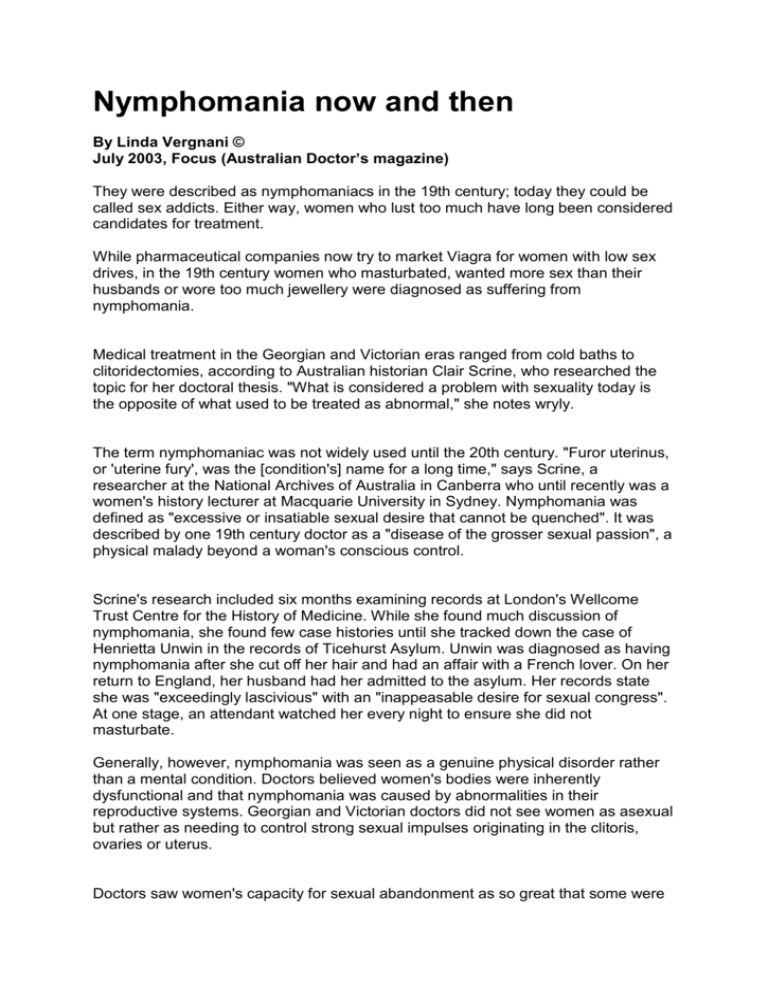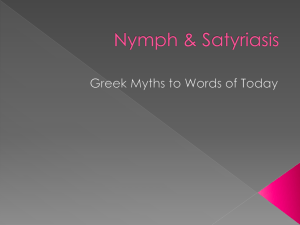
Nymphomania now and then
By Linda Vergnani ©
July 2003, Focus (Australian Doctor’s magazine)
They were described as nymphomaniacs in the 19th century; today they could be
called sex addicts. Either way, women who lust too much have long been considered
candidates for treatment.
While pharmaceutical companies now try to market Viagra for women with low sex
drives, in the 19th century women who masturbated, wanted more sex than their
husbands or wore too much jewellery were diagnosed as suffering from
nymphomania.
Medical treatment in the Georgian and Victorian eras ranged from cold baths to
clitoridectomies, according to Australian historian Clair Scrine, who researched the
topic for her doctoral thesis. "What is considered a problem with sexuality today is
the opposite of what used to be treated as abnormal," she notes wryly.
The term nymphomaniac was not widely used until the 20th century. "Furor uterinus,
or 'uterine fury', was the [condition's] name for a long time," says Scrine, a
researcher at the National Archives of Australia in Canberra who until recently was a
women's history lecturer at Macquarie University in Sydney. Nymphomania was
defined as "excessive or insatiable sexual desire that cannot be quenched". It was
described by one 19th century doctor as a "disease of the grosser sexual passion", a
physical malady beyond a woman's conscious control.
Scrine's research included six months examining records at London's Wellcome
Trust Centre for the History of Medicine. While she found much discussion of
nymphomania, she found few case histories until she tracked down the case of
Henrietta Unwin in the records of Ticehurst Asylum. Unwin was diagnosed as having
nymphomania after she cut off her hair and had an affair with a French lover. On her
return to England, her husband had her admitted to the asylum. Her records state
she was "exceedingly lascivious" with an "inappeasable desire for sexual congress".
At one stage, an attendant watched her every night to ensure she did not
masturbate.
Generally, however, nymphomania was seen as a genuine physical disorder rather
than a mental condition. Doctors believed women's bodies were inherently
dysfunctional and that nymphomania was caused by abnormalities in their
reproductive systems. Georgian and Victorian doctors did not see women as asexual
but rather as needing to control strong sexual impulses originating in the clitoris,
ovaries or uterus.
Doctors saw women's capacity for sexual abandonment as so great that some were
reluctant to use a speculum on patients or administer anaesthetics during childbirth
for fear of stimulating patients. Masturbation and touching the genitals were seen as
factors that could trigger nymphomania.
In an 1828 treatise, psychiatrist George Man Burrows wrote that no matter how
naturally virtuous a woman might be, genital irritation would excite wanton feelings
which could then "proceed to revolting extremes".
During examinations and post-mortems, physicians looked for proof of
nymphomania, like an enlarged clitoris or ovarian cysts. Among the range of
treatments suggested by London obstetric physician Dr David Davis was "the
application of leeches to the parts to induce enough bleeding until the patient
fainted".
Applying astringents or caustics to the woman's genitals was another treatment.
Scrine says this was "explicitly designed to prevent a woman's masturbation by both
deadening the sensation of the clitoris and producing blistering which made the area
too painful to touch".
Most controversial was surgical removal of the clitoris and later the ovaries as a
treatment for nymphomania. In a paper published in 1866, Dr Isaac Baker Brown,
president of the Medical Society of London, wrote that the only permanent cure for
nymphomania was to remove the clitoris, the "source of evil", adding that he had
never seen a recurrence of the disease after this treatment (for which he did not
obtain patients' consent).
However, clitoridectomy was generally regarded as very radical and suspect
because of its "primitive associations" with female circumcision in Africa and
elsewhere. Milder remedies included "soothing" the genitals by inserting ice,
belladonna or even deadly nightshade into the vagina.
Scrine believes some of the 19th century concerns about nymphomania arose
simply because Victorian men were often older than their wives and may have been
unable to satisfy them. "I think some of the men were impotent," she says. . In
contrast, there was virtual silence about the male equivalent of nymphomania,
satyriasis. "A man's excess was a momentary lapse that was the privilege of any
healthy, virile male," Scrine says.
While the American Psychiatric Association's standard manual did not drop the
diagnosis of nymphomania until 1987, today the term would be considered archaic.
However, the term "sexual addiction" is widely accepted. In Australia and the US,
self-confessed sufferers join sex addicts' groups and may even be admitted to
hospital for psychological treatment. Sex addicts might indulge in sex with numerous
anonymous partners or obsessively masturbate.
Dr Jules Black, a Sydney gynaecologist, sexologist and former secretary-general of
the World Association for Sexology, says he still sees patients who describe
themselves as suffering from nymphomania. When he asks what they mean by this,
they usually explain that their partner has called them a nymphomaniac, in some
cases when the woman has left the partner for another man.
Dr Black says: "Men label women in this derogatory way - 'Oh yes, you are a
nympho' - just because her drive is somewhat higher than his and the man can't
cope. Men are very good at putting women down. They are so jealous because
women can have multiple orgasms."
Dr Black is shocked at the drastic treatments 19th century doctors meted out, but as
a gynaecologist he can cite medical reasons why some women seem insatiable. Like
the Victorian doctors, he has observed cases where itching from a fungal infection of
the genitals caused intense sexual excitement.
"I've seen elderly women in the nursing home who suddenly start jumping men or
masturbating like mad because they have a fungal infection." A tumour on the
amygdala could also cause insatiable desire, he says.
Dr Black has seen patients whose compulsive desire for sex causes them misery.
These women seek constant sex in the same way as a Don Juan who needs a daily
conquest to boost low self-esteem. He refers such patients to psychiatrists or
behavioural psychologists.
Often patients who are hooked on sex also have an addiction to drugs like ecstasy,
or are depressed. It interferes with sufferers' relationships, work and social life.
"We see sex addiction as a compulsive behaviour used to medicate underlying
feelings," says Heather Bray, a psychologist at Sydney's South Pacific Private
Hospital, which offers in-patient treatment of sex addiction.
Bray says every case is different, but some sex addicts masturbate 20 or 30 times
daily, while others constantly log on to web pornography sites or repeatedly visit
prostitutes. "The cases I have seen are predominantly men, but it's certainly not
confined to men," she says.
At the hospital, sex addiction is treated with group therapy to help patients come to
terms with their emotional experiences. The reason for in-patient treatment is that
sex addiction is potentially fatal. "There are people who will commit suicide because
they are so stressed and their lives have become so disrupted," Bray says.
Dr Gabriella Morrissey, head of the sexology program at Curtin University of
Technology in Perth and author of the book <I>Urge<I>, says that until the mid1990s sex addiction was seen as a joke. At that time the term did not hold any
validity among psychologists. It was seen as part of the celebrity culture, with film
star Michael Douglas among those alleged to be a sex addict.
However, Dr Morrissey says that as "more tragic" stories emerged of people whose
relationships had been ruined by destructive sexual behaviour, researchers
recognised this was a valid addiction requiring treatment. It takes many different
forms and might result in illegal activity. "If you are a sex addict and desiring sex to
the point where you are drink spiking or coercing, then you are breaching the lines of
consent, obviously," she says.
But is sex addiction really the modern version of nymphomania? "It is really an
apples-and-oranges comparison because of the complete change in how female
sexuality is understood and the attitudes to female desire, let alone sexual
behaviour," Dr Morrissey says.
"[In the past, nymphomania had the] connotation of being seriously unhealthy and
abnormal and going against what is expected of women. Now we recognise that
women have a healthy sex drive and can initiate sex as often as men, and that can
be seen as normal."
Except that the most recent epidemic seems to be lack of desire (due to stressed
modern lifestyles, among other factors), rather than too much of it. Scrine is
particularly interested in the current emphasis on female sexual dysfunction, a lack
of desire that would probably meet the Victorian ideal. In some ways, it seems, the
thinking on female sexuality has come full circle.
Copyright Linda Vergnani.









